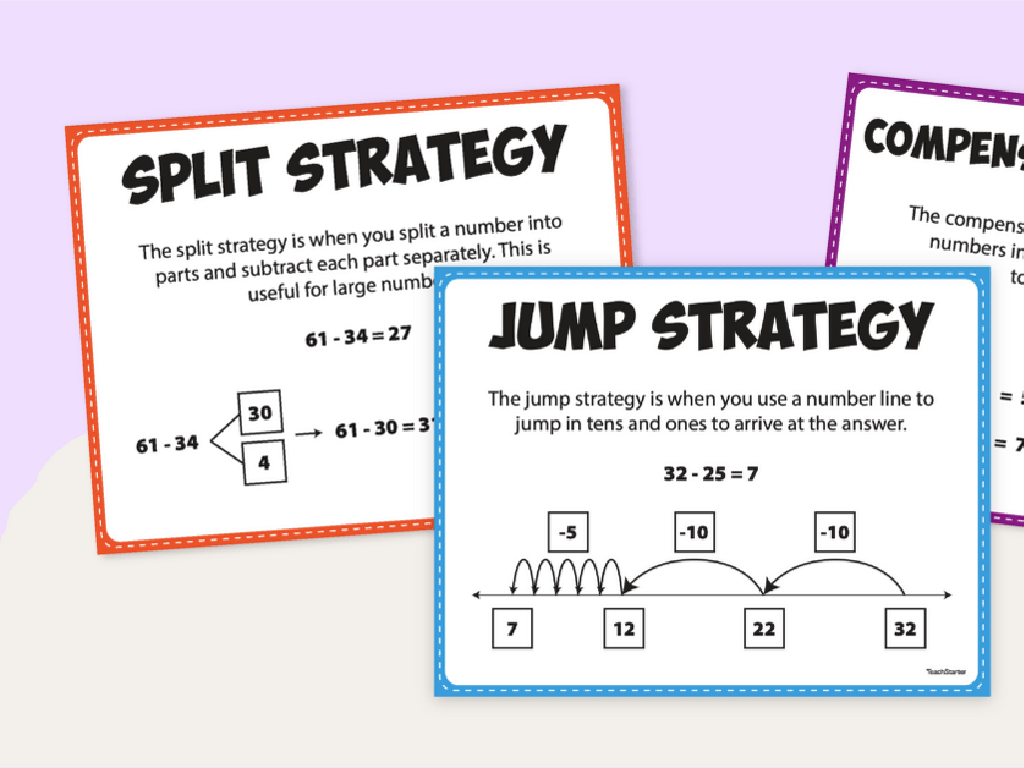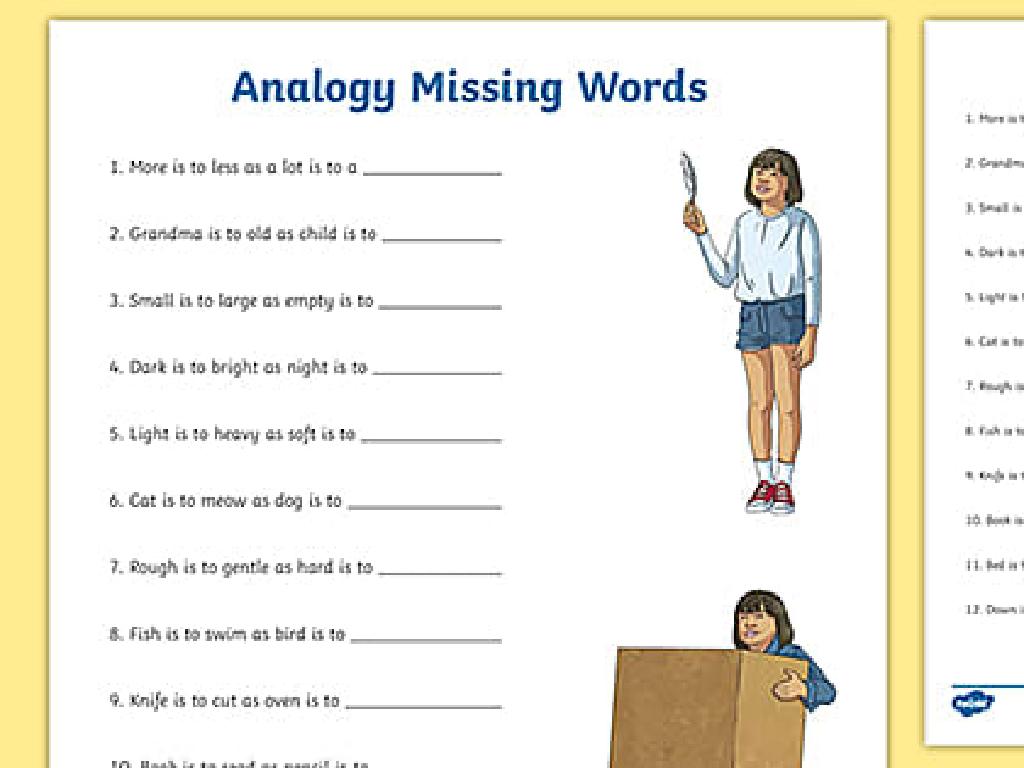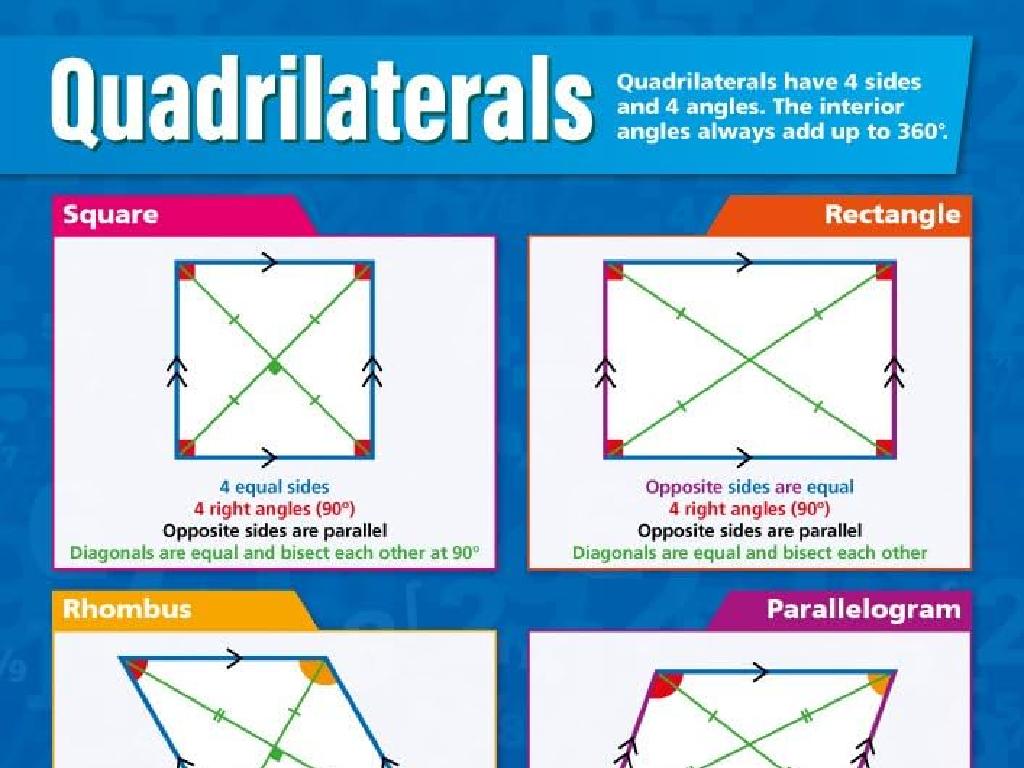Identify Dependent And Independent Clauses
Subject: Language arts
Grade: Eighth grade
Topic: Phrases And Clauses
Please LOG IN to download the presentation. Access is available to registered users only.
View More Content
Understanding Sentences: Dependent & Independent Clauses
– Distinction between phrases & clauses
– Phrases are groups of words without a subject-verb combo, clauses have both.
– Clauses: Independent vs. Dependent
– Independent clauses can stand alone as sentences; dependent clauses cannot.
– Characteristics of independent clauses
– An independent clause expresses a complete thought and has a subject and a verb.
– Recognizing dependent clauses
– Dependent clauses also have a subject and a verb but don’t express a complete thought.
|
This slide introduces the fundamental components of sentence structure: phrases and clauses. Begin by explaining the difference between a phrase (a group of words) and a clause (a group of words with a subject and verb). Emphasize that an independent clause is a complete sentence on its own, while a dependent clause relies on an independent clause to form a complete sentence. Use examples to illustrate these concepts, such as ‘Because I was late’ (dependent) versus ‘I was late’ (independent). Encourage students to identify clauses in sample sentences and determine whether they are independent or dependent, reinforcing their understanding of how clauses function within the framework of sentence construction.
Understanding Clauses in Sentences
– Define a clause
– A clause is a group of words with a subject and a verb.
– Clause vs. Phrase
– Phrases are groups of words without a subject-verb pair, unlike clauses.
– Examples of clauses
– ‘Because I was late’ (dependent), ‘I missed the bus’ (independent).
– Identifying clauses in practice
|
Begin the lesson by defining a clause and ensuring students understand its components: a subject and a verb. Contrast clauses with phrases, highlighting that phrases lack a subject-verb pair. Provide clear examples of both independent and dependent clauses within sentences to illustrate their differences. For instance, in the sentence ‘I missed the bus because I was late,’ ‘I missed the bus’ is an independent clause, and ‘because I was late’ is a dependent clause. Encourage students to identify clauses in sentences they encounter in their reading or in class discussions. This will help them understand how clauses form the building blocks of sentences and how they function within the context of writing.
Exploring Independent Clauses
– Define an independent clause
– A complete thought that can stand alone as a sentence.
– Characteristics of independent clauses
– They have a subject, verb, and express a complete thought.
– Examples of independent clauses
– ‘She runs every morning.’ ‘The sun set.’
|
This slide aims to introduce students to the concept of independent clauses, which are the building blocks of sentences. An independent clause contains a subject and a verb and expresses a complete thought, meaning it can stand alone as a sentence. Emphasize the importance of recognizing independent clauses as they will encounter them frequently in their writing. Provide clear examples to illustrate independent clauses in action. Encourage students to create their own sentences that qualify as independent clauses to reinforce their understanding.
Understanding Dependent Clauses
– Define a dependent clause
– A clause that cannot stand alone as a sentence
– Characteristics of dependent clauses
– They must be connected to an independent clause
– Examples of dependent clauses
– ‘Because she was late,’ ‘If you build it,’ ‘When the rain stops,’
|
This slide aims to help students identify and understand dependent clauses within sentences. A dependent clause is a group of words that contains a subject and a verb but does not express a complete thought and can’t stand alone as a sentence. It’s important to highlight that dependent clauses are often introduced by subordinating conjunctions such as ‘because,’ ‘if,’ or ‘when.’ Provide students with examples of dependent clauses and ask them to identify the subject and verb in each. Encourage them to create their own sentences using dependent clauses to ensure they grasp the concept. In the next class, we can have students work in pairs to create complex sentences that include both independent and dependent clauses.
Combining Clauses: Crafting Complex Sentences
– Combine independent & dependent clauses
– Independent clauses can stand alone; dependent clauses cannot.
– Use conjunctions & punctuation
– Conjunctions like ‘and’, ‘but’, ‘because’ connect clauses; commas and semicolons punctuate them.
– Create complex sentences
– Complex sentences have at least one independent clause and one or more dependent clauses.
|
This slide aims to teach students how to effectively combine independent and dependent clauses to create complex sentences, which are crucial for advanced writing. Start by explaining the difference between independent (complete thoughts) and dependent clauses (incomplete thoughts). Then, demonstrate how conjunctions (for, and, nor, but, or, yet, so) and punctuation (commas, semicolons) are used to connect these clauses. Provide examples of complex sentences and have students practice creating their own. Encourage them to experiment with different conjunctions and clause arrangements to see how the meaning and flow of their sentences change.
Identifying Clauses in Sentences
– Tips for spotting clauses
– Look for subjects and verbs; they form the clause’s core.
– Practice with example sentences
– We’ll dissect sentences to find independent and dependent clauses.
– Discuss clause recognition
– Recognizing clauses helps us understand sentence structure and complexity.
– Understanding clause types
– Independent clauses can stand alone; dependent clauses cannot.
|
This slide aims to equip students with the skills to identify and differentiate between independent and dependent clauses within sentences. Start by explaining that a clause is a group of words containing a subject and a verb. Provide tips such as looking for these core elements to spot clauses. During practice, use example sentences and have students identify the clauses within them. Discuss the importance of recognizing different clauses, emphasizing how this knowledge contributes to better writing and comprehension skills. Understanding the distinction between independent clauses, which can form complete sentences on their own, and dependent clauses, which cannot, is crucial for constructing well-formed sentences.
Class Activity: Clause Scavenger Hunt
– Understand scavenger hunt rules
– Work in pairs on clause identification
– Partner up and collaborate to explore clauses
– Find independent and dependent clauses
– Look for clauses that stand alone (independent) and those that don’t (dependent)
– Share discoveries with the class
|
This interactive class activity is designed to help students apply their knowledge of independent and dependent clauses in a practical and engaging way. Students will work in pairs to sift through provided texts, identifying examples of each type of clause. This collaborative effort encourages peer learning and discussion. After the scavenger hunt, each pair will present their findings to the class, fostering a deeper understanding through teaching and reinforcing the concept for both presenter and audience. Possible texts for the activity include excerpts from novels, articles, or textbooks. Ensure that the texts are varied and suitable for the grade level. Provide guidance on how to distinguish between the two types of clauses, and consider offering a worksheet for students to record their findings.
Wrapping Up: Clauses and Complex Sentences
– Review of clause concepts
– Significance of clauses in writing
– Homework: Craft complex sentences
– Create 10 sentences with both independent and dependent clauses.
– Aim for clarity and coherence
– Ensure each sentence is clear and flows logically.
|
As we conclude today’s lesson on independent and dependent clauses, it’s crucial to emphasize the role these concepts play in crafting effective and nuanced writing. Understanding how to combine clauses into complex sentences allows for more sophisticated expression of ideas. For homework, students are tasked with writing ten complex sentences that incorporate both independent and dependent clauses. This will reinforce their learning and provide practice in constructing clear, coherent sentences. Encourage students to focus on the relationship between the clauses and how they work together to enhance the meaning of their sentences. During the next class, we can review some of the sentences to highlight the importance of clause structure in writing.





